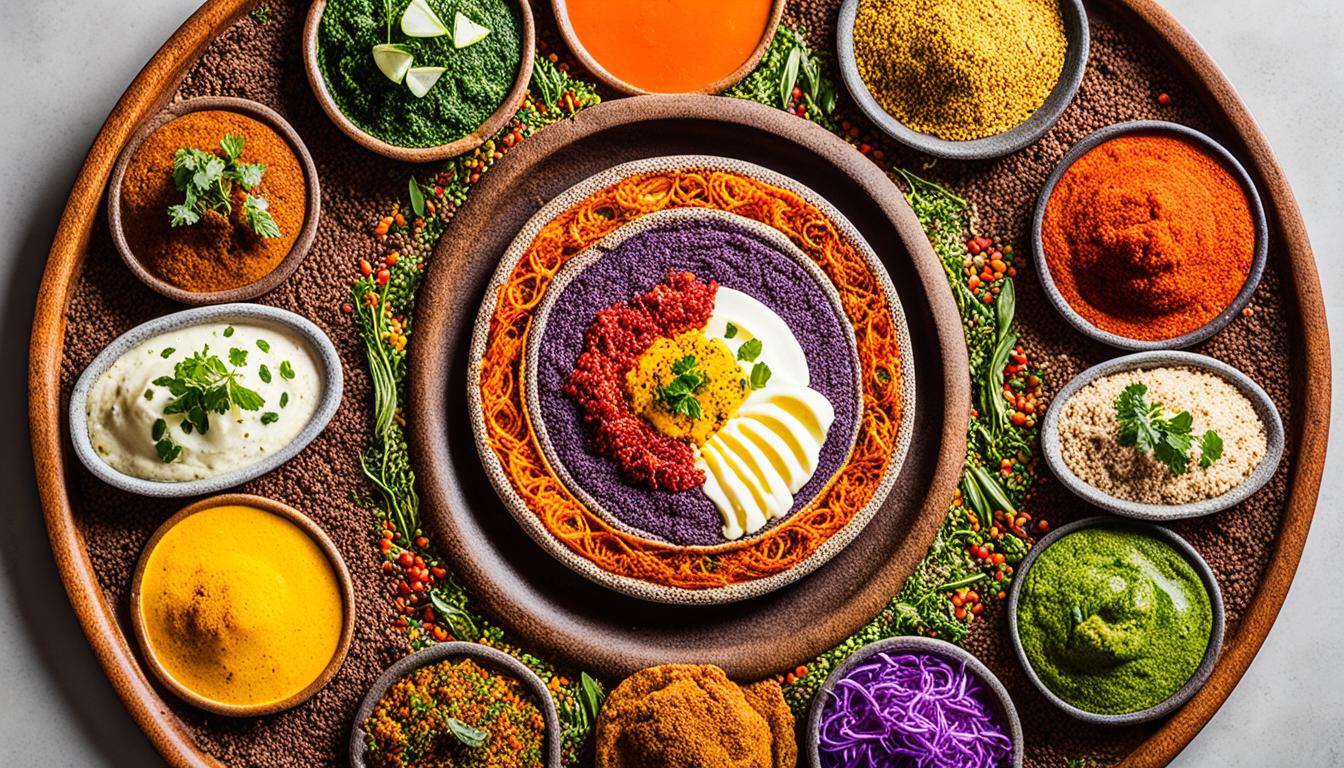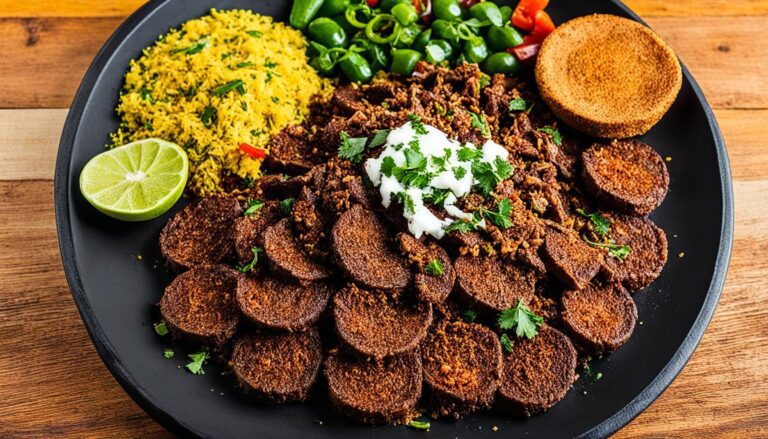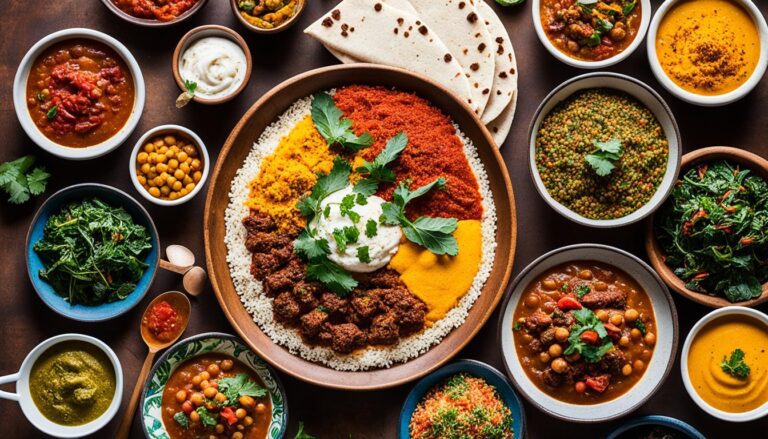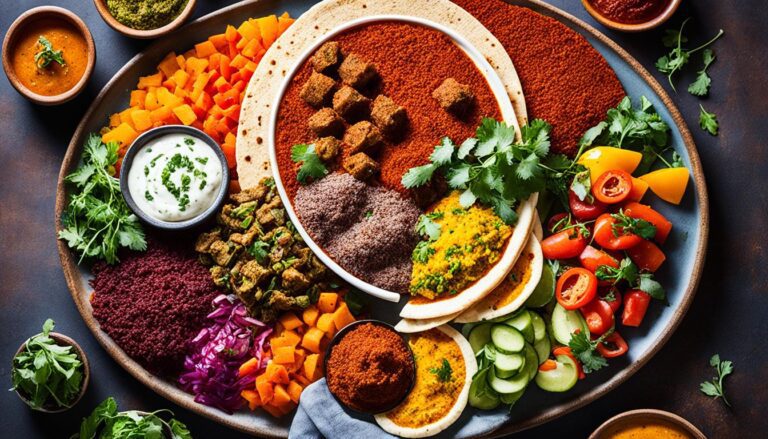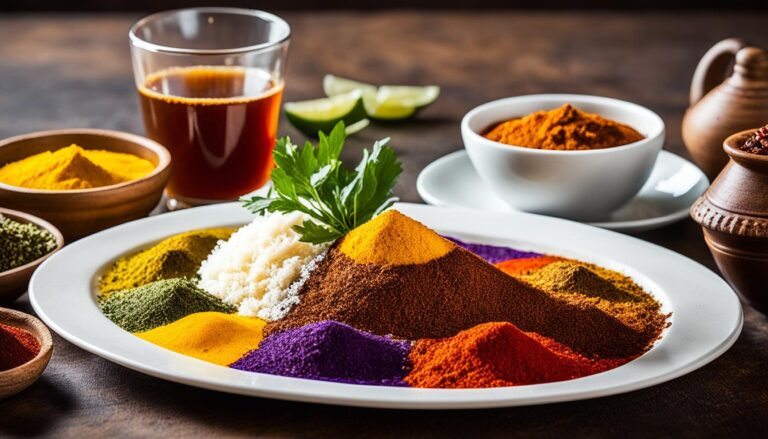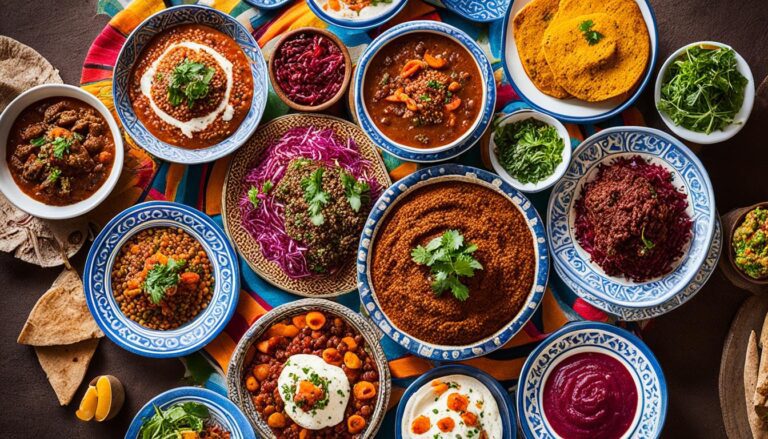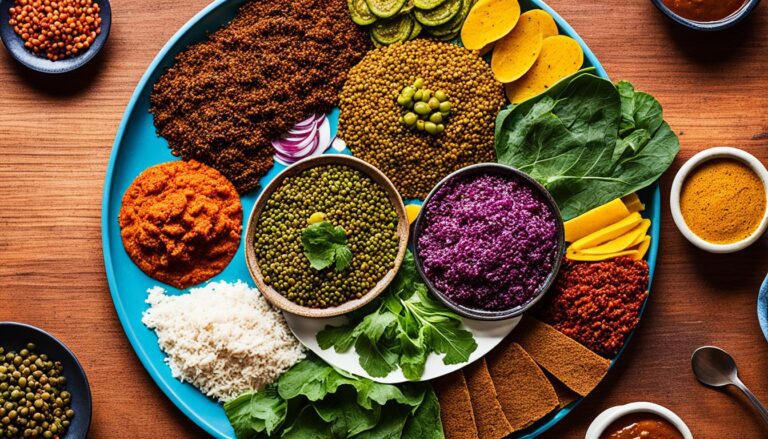How Is Ethiopian Food?
Welcome to our exploration of the vibrant world of Ethiopian cuisine! Get ready to embark on a culinary adventure like no other as we delve into the rich traditions and breathtaking flavors that define Ethiopian food. From injera to berbere and everything in between, discover the unique tastes that make Ethiopian cuisine a true feast for the senses.
Have you ever wondered what sets Ethiopian food apart from other cuisines? How do they achieve such bold and exotic flavors? What traditional dishes are the heart and soul of Ethiopian culture? Join us on this journey as we uncover the secrets and intricacies of Ethiopian gastronomy.
Key Takeaways:
- Explore the unique flavors and rich traditions of Ethiopian cuisine
- Discover the traditional dishes that make Ethiopian food so special
- Experience the bold and exotic flavors of Ethiopian stews and vegetarian options
- Learn about the art of Ethiopian cooking and the techniques behind it
- Dive into the regional varieties of Ethiopian cuisine and their cultural significance
Ethiopian Cuisine: A Taste of Tradition and Culture
Ethiopian cuisine is a true reflection of the country’s rich culture and deep-rooted traditions. Exploring Ethiopian food is not just a culinary experience; it’s an opportunity to immerse yourself in the vibrant traditions of this East African nation.
At the heart of Ethiopian cuisine are the traditional dishes that have been passed down through generations. One such dish is injera, a spongy bread-like staple that serves as the foundation for many Ethiopian meals. Made from fermented teff flour, injera offers a unique texture and taste that perfectly complements the flavors of Ethiopian dishes.
But it’s not just injera that makes Ethiopian food special. The use of spices is another defining aspect of Ethiopian cuisine. Berbere, a blend of spices that typically includes chili peppers, garlic, ginger, and various aromatic herbs, adds depth and complexity to Ethiopian dishes. The fiery and aromatic flavors of berbere bring a delightful kick to the palate, making every bite an adventure for the taste buds.
Ethiopian cuisine is also known for its use of other aromatic spices, such as cumin, coriander, and cardamom, which further enhance the flavors of the dishes. These spices create a symphony of tastes that reflect the diversity and uniqueness of Ethiopian culture.
The Art of Injera and Berbere
Injera and berbere are not just ingredients; they are symbols of Ethiopian culture. Injera represents the communal aspect of Ethiopian dining, where everyone gathers around a large platter and shares the meal together. It is customary to break off pieces of injera and use them to scoop up the various dishes, fostering a sense of togetherness and unity.
Berbere, on the other hand, symbolizes the bold and vibrant flavors that define Ethiopian cuisine. Its distinct blend of spices reflects the country’s rich cultural heritage and adds a touch of warmth and intensity to every bite.
To truly appreciate Ethiopian cuisine, one must embrace the traditions and flavors that have been carefully preserved for centuries. It’s not just about the food; it’s about experiencing the essence of Ethiopia through its delicious and aromatic dishes.
Exploring Ethiopian Flavors: Bold and Exotic
Ethiopian cuisine is a treasure trove of bold and exotic flavors that will transport your taste buds to a whole new world. From spicy stews that pack a punch to delectable vegetarian options bursting with flavor, Ethiopian food has something to offer for everyone. The richness of Ethiopian flavors is a result of the country’s diverse culinary heritage and the unique ingredients used in their dishes.
One of the highlights of Ethiopian cuisine is its assortment of spicy stews, known as “wats.” These stews are made with a blend of aromatic spices, such as berbere, a fiery Ethiopian spice mix that adds layers of complexity and heat to the dishes. Each wat has its own distinct flavor profile, ranging from mild to extra spicy, allowing you to tailor your dining experience according to your spice tolerance.
For those with vegetarian preferences, Ethiopian cuisine offers a wide array of flavorful options. Ethiopian vegetarian dishes are usually made with lentils, chickpeas, or vegetables, cooked with fragrant spices and herbs. The combination of these ingredients creates robust and satisfying flavors that rival their meat counterparts. Try the famous Misir Wat, a spicy red lentil stew, or the Kik Alicha, a mild yellow split pea stew, for a taste of the vegetarian delights that Ethiopian cuisine has to offer.
What sets Ethiopian cuisine apart is its use of unique ingredients that contribute to its distinct flavor profile. One such ingredient is injera, a sourdough flatbread made from fermented teff flour. Injera not only serves as a staple in Ethiopian meals but also plays an essential role in enhancing the flavors of other dishes. Its tangy and slightly sour taste pairs perfectly with the spicy stews and adds a delightful dimension to your dining experience.
Another unique ingredient used in Ethiopian cooking is niter kibbeh, a spiced clarified butter. This aromatic butter is made by simmering butter with spices like turmeric, cardamom, and cinnamon. The result is a flavorful cooking medium that imparts richness and depth to many Ethiopian dishes. It’s a key ingredient in preparing traditional Ethiopian dishes like Doro Wat, a spicy chicken stew, and Kitfo, a dish made from minced raw meat.
In this section, we’ve only scratched the surface of the bold and exotic flavors that Ethiopian cuisine offers. But hopefully, it has ignited your curiosity to explore further and indulge in the vibrant taste sensations that await you. Brace yourself for a culinary adventure like no other as we continue our journey through the fascinating world of Ethiopian food.
The Art of Ethiopian Cooking: Techniques and Methods
In Ethiopian cuisine, cooking is considered an art form, with each dish reflecting a unique blend of techniques and methods. The use of these techniques not only enhances the flavors but also adds depth to the overall dining experience. Let’s explore some of the key elements that make Ethiopian cooking truly special.
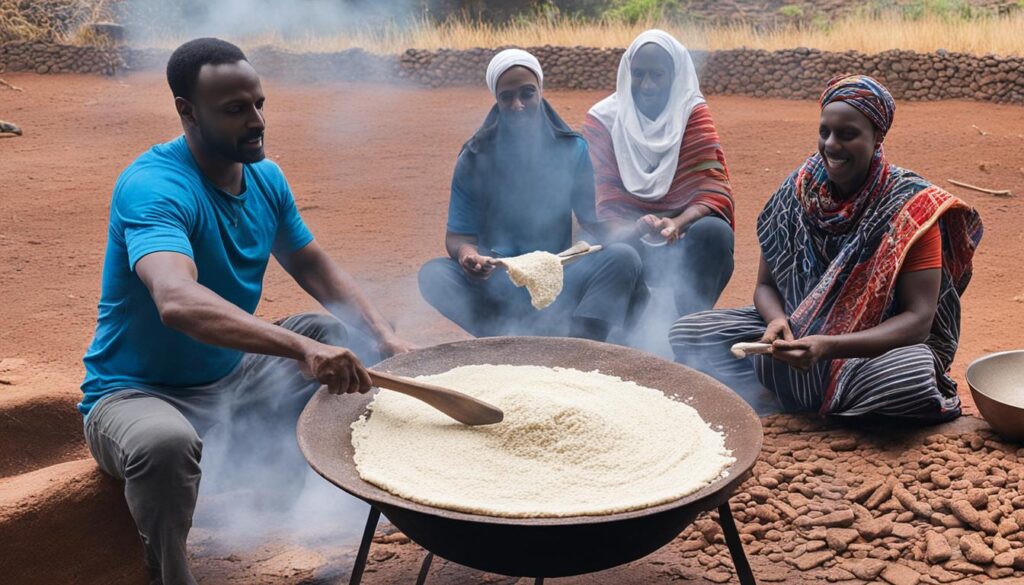
Fermentation: Unleashing Flavor Potential
Fermentation plays a crucial role in Ethiopian cooking, contributing to the distinctive taste and aroma of many dishes. One of the most well-known fermented ingredients is injera, a sourdough-like bread made from teff flour. This process involves the natural fermentation of the teff flour batter for up to 48 hours, resulting in a slightly tangy and fluffy bread that perfectly complements the rich flavors of Ethiopian stews and sauces.
Slow Cooking: Infusing Depth and Intensity
Another technique commonly used in Ethiopian cuisine is slow cooking. The slow and gradual simmering of ingredients allows the flavors to meld together, creating a rich and complex taste profile. Dishes such as Doro Wat, a spicy chicken stew, and Misir Wot, a lentil stew, are often cooked over low heat for an extended period, allowing the spices and aromatics to infuse the dish with their distinct flavors.
Communal Dining: Sharing the Experience
In Ethiopian culture, dining is a communal experience that brings people together. Traditionally, meals are shared from a large communal plate called a mesob. This shared dining approach fosters a sense of togetherness and encourages bonding within the community. It’s a beautiful way to connect with family and friends while enjoying the vibrant flavors of Ethiopian cuisine.
Regional Varieties: Ethiopia’s Culinary Diversity
Ethiopia is a country rich in cultural diversity, and this is reflected in its regional cuisines. Each region offers its own unique culinary traditions, making Ethiopian food a true delight for the taste buds. Join us on a culinary journey through Ethiopia as we explore the various regional varieties of Ethiopian cuisine.
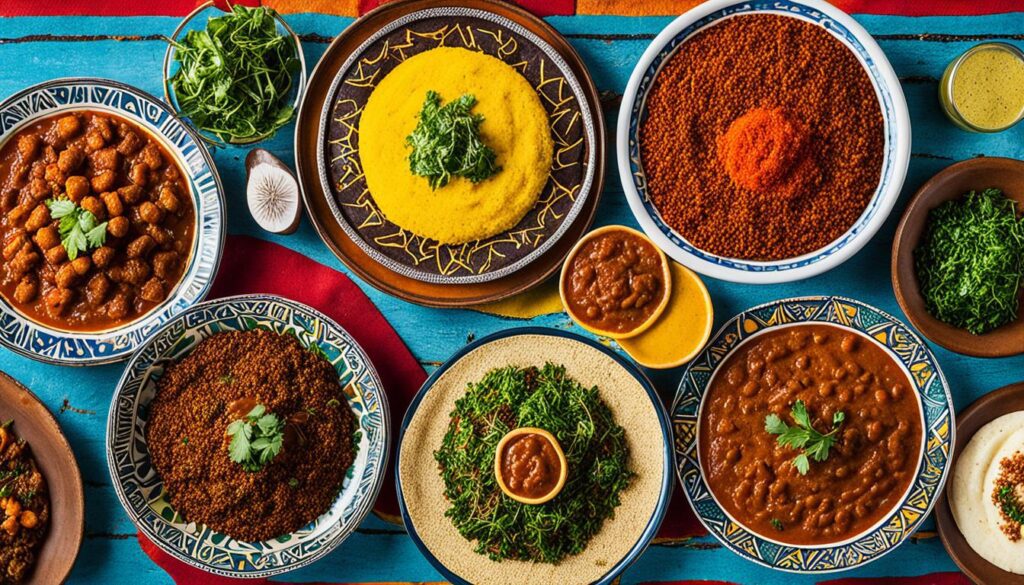
Exploring Injera Variations
One of the most iconic elements of Ethiopian cuisine is injera, a spongy flatbread that serves as the foundation for many dishes. However, the preparation and taste of injera can vary from one region to another. In the northern part of Ethiopia, injera is often thicker and has a sour taste due to a longer fermentation process. In contrast, in the southern regions, injera tends to be thinner and has a milder flavor. These variations in injera reflect the diverse preferences and culinary practices across Ethiopia.
Specialty Dishes from Different Regions
Each region in Ethiopia has its own specialty dishes that showcase the local flavors and ingredients. In the Amhara region, you’ll find dishes like doro wat, a spicy chicken stew, and kitfo, a minced meat dish seasoned with spices. The Oromia region is known for its delicious tibs, grilled or sautéed meat or vegetables, often served with injera. In the Tigray region, shiro, a flavorful vegetarian stew made from ground chickpeas or lentils, is a popular choice.
From the spicy flavors of the east to the milder tastes in the west, Ethiopian regional cuisines offer a wide range of specialty dishes that highlight the country’s cultural diversity. Exploring these unique flavors and ingredients is like embarking on a culinary adventure through Ethiopia.
Continue reading to uncover more hidden gems of Ethiopian cuisine beyond injera and doro wat in our next section.
Ethiopian Food: Beyond Injera and Doro Wat
While injera and doro wat may be the most well-known Ethiopian dishes, there is so much more to explore. Ethiopian cuisine offers a delightful array of flavors and dishes that go beyond the familiar staples.
One dish you must try is kitfo, a spicy minced raw meat dish typically made from beef. It is often served with injera and a variety of condiments, allowing you to customize the flavors to your liking. Kitfo’s unique combination of spices and textures is sure to tantalize your taste buds.
If you prefer a cooked meat option, tibs is a must-try. These sautéed meat dishes are packed with flavor and can be made with various meats such as beef, lamb, or chicken. The meat is typically marinated with spices, onions, and peppers before being cooked to perfection.
For those seeking a vegetarian option, shiro is a delicious choice. Made from ground chickpeas or lentils, this thick stew is seasoned with spices and served with injera or bread. The combination of the hearty stew and the sourness of the injera creates a delightful balance of flavors.
Expand your culinary horizons and venture beyond injera and doro wat to discover the wonders of kitfo, tibs, and shiro. These lesser-known Ethiopian dishes will introduce you to a whole new world of flavors and textures.
Ethiopian Food Culture: Sharing and Celebrating Together
Ethiopian food culture revolves around the values of community, togetherness, and celebration. It is a deeply ingrained aspect of Ethiopian society, where food is not just a means of sustenance but also a way to connect with others and express love and hospitality.
In Ethiopian culture, communal eating is highly valued. Shared meals bring people together, fostering a sense of unity and creating lasting bonds. It is common for Ethiopians to eat from a communal platter called a “mesob,” where everyone sits together and shares the same food. This practice promotes a spirit of sharing, generosity, and equality among individuals.
Another significant aspect of Ethiopian food culture is the traditional coffee ceremony. Coffee holds great importance in Ethiopian customs and is often a centerpiece of social gatherings. The coffee ceremony is a cherished ritual where freshly roasted coffee beans are washed, ground, and brewed in front of guests. This process is accompanied by the rich aroma of coffee and the sounds of Ethiopian music, creating a warm and inviting atmosphere.
Throughout Ethiopia, food plays a central role in various celebrations and festivals. From religious holidays like Orthodox Christmas to cultural events such as Timkat (Epiphany), Ethiopians come together to enjoy traditional dishes and rejoice in the spirit of the occasion. These festive gatherings are filled with laughter, music, and dancing, creating cherished memories and strengthening family and community ties.
Ethiopian food culture is a testament to the country’s rich heritage and the importance of community. By embracing communal eating, celebrating through the coffee ceremony, and coming together in times of joy, Ethiopians demonstrate the power of food to unite and foster a sense of belonging. Join us as we uncover more about the vibrant culinary traditions of Ethiopia in this captivating culinary adventure.
Conclusion
Embark on a culinary adventure like no other and explore the vibrant world of Ethiopian cuisine. With its unique flavors, rich traditions, and diverse regional cuisines, Ethiopian food offers a truly immersive and tantalizing experience.
From the spongy injera bread to the bold and exotic spices like berbere, Ethiopian cuisine is a celebration of flavors that will delight your taste buds. Whether you prefer spicy stews or flavorful vegetarian options, there is something for everyone in this diverse and dynamic culinary tradition.
But Ethiopian food is more than just a culinary delight. It is a reflection of the country’s rich cultural heritage and communal values. The art of Ethiopian cooking, with its techniques and methods passed down through generations, invites us to slow down, savor the flavors, and appreciate the importance of communal dining.
So come along on this culinary journey and discover the wonders of Ethiopian cuisine. Whether you’re a seasoned food lover or a curious adventurer, the flavors, traditions, and diversity of Ethiopian food are sure to leave a lasting impression on your taste buds and your heart.

